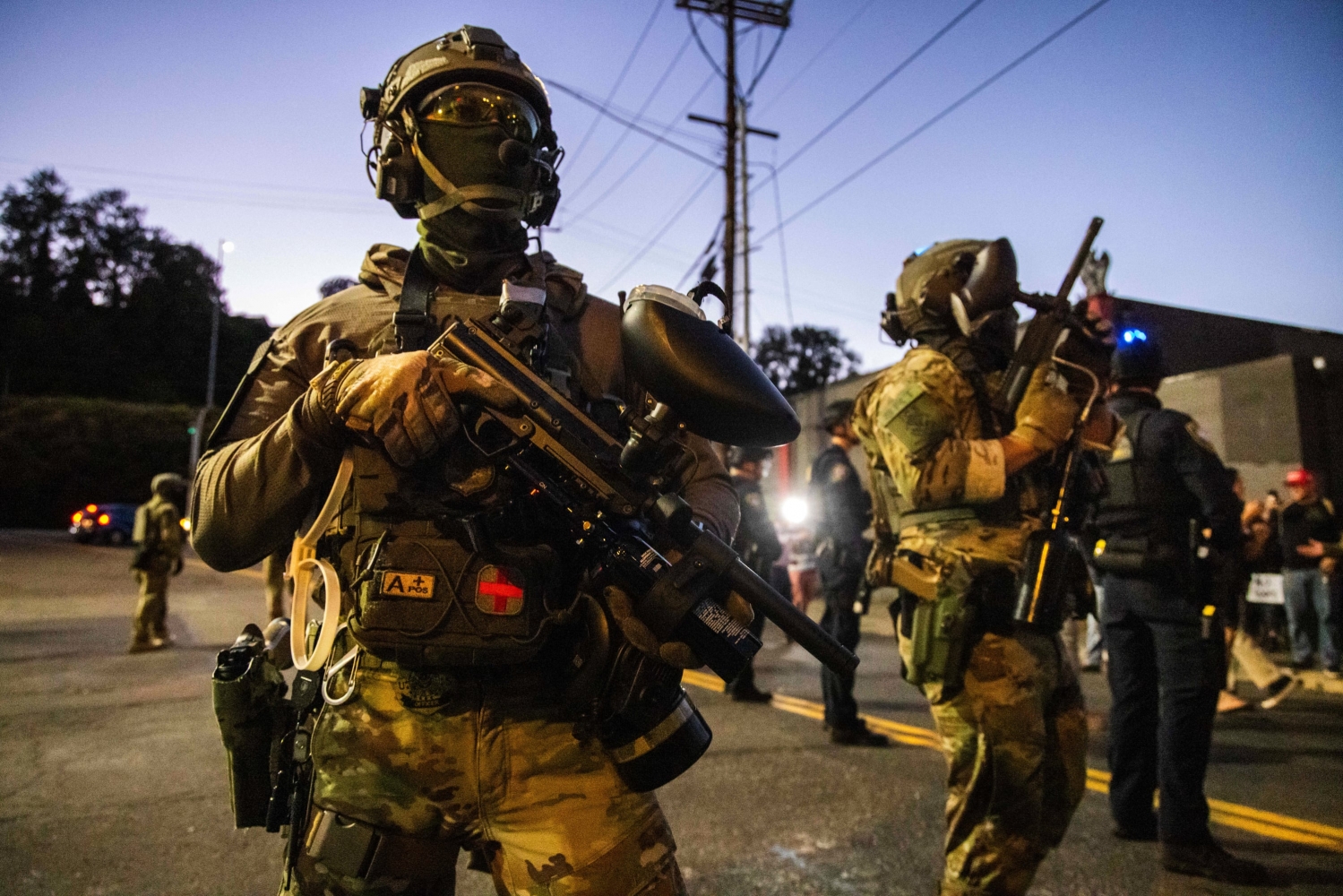

Published on: 10/20/2025
This news was posted by Oregon Today News
Description
A lot has happened from the time President Donald Trump announced he’d be sending National Guard troops to Portland through Saturday’s “No Kings” protest that saw tens of thousands of people peacefully marching through the city’s streets, with a very strong frog contingent.
And it’s only been about three weeks.
Here’s a quick look at how things have progressed and what’s still ahead.

Friday, Sept. 26: An anticipated surge in federal forces
People in Portland started hearing reports of a surge in the number of federal law enforcement present in the city.
After multiple sightings of armored cars coming and going from the Immigration and Customs Enforcement facility in Portland, local elected officials held a press conference urging Portlanders to stay calm and not “take the bait” from the Trump administration’s show of force.
Saturday, Sept. 27: Trump calls in the National Guard
President Trump announced in a post on Truth Social that he was ordering federal troops to “protect War ravaged Portland.”
Oregon Gov. Tina Kotek and Portland Mayor Keith Wilson urged Trump to take back his order, stating that the number of troops needed in Portland is zero, and that the president’s idea of the city as war-ravaged is wholly inaccurate.
Police records show that at this time, protests at the ICE facility had been consistently small and uneventful for more than a month.
‘The number of necessary troops is zero’: Portland mayor responds to Trump announcement
Sunday, Sept. 28: States sue to block deployment
Despite objections from more than 100 Oregon leaders, Trump authorized 200 members of the state’s National Guard, using federal authority to deploy them into Portland.
The state of Oregon and city of Portland promptly sued the Trump administration in an attempt to block the deployment.
Hundreds protest at ICE building after Trump’s announcement of troop deployment to Portland
Saturday, Oct. 4: US District Court halts Trump’s deployment
U.S. District Court Judge Karin Immergut granted Oregon and Portland a temporary restraining order, halting Trump’s deployment at least through Oct. 17.
Immergut, a Trump appointee in 2019, took over the case after Judge Michael Simon recused himself. Simon is married to Oregon Rep. Suzanne Bonamici, a Democrat who has opposed Trump’s troop deployment.
Hours after Immergut ruled against Trump’s deployment, federal officers at the ICE facility escalated the crowd control tactics they were using on protesters.




















‘OPB Politics Now’: President Trump targets Portland
Sunday, Oct. 5: Trump circumvents the judge, who blocks him again
In an early morning interview with reporters on the White House lawn, Trump criticized Immergut over her ruling. He appeared not to know who she was, mistakenly referring to her multiple times as a male judge.
Following that District Court ruling blocking his deployment of the Oregon National Guard, Trump instead ordered 300 troops from the California National Guard and 400 additional troops from Texas, which he’d already brought under federal command.
Immergut swiftly held another hearing and issued another ruling temporarily blocking those deployments. She told attorneys for the Trump administration she was “troubled” by the deployment of the guard from two other states, saying it “does appear to be in direct contradiction of my order.”
ICE building neighbors clean up, reflect following latest Portland protests
Tuesday, Oct. 7: Homeland Security Secretary Noem visits Portland
In the midst of ongoing tensions between local leaders and the Trump administration, U.S. Department of Homeland Security Secretary Kristi Noem visited Portland’s ICE facility and met with Gov. Kotek.

Her visit followed an effort by the Trump administration to portray the city as chaotic and in need of federal troops. Noem was flanked for much of her visit by right-wing media influencers who have been a frequent presence at the ICE protests.
This is part of a pattern OPB documented of right-wing media influencers being welcomed into the federal government to promote its messages. This kind of media access shows a deepening alliance between the administration and an online world willing to represent information toward furthering Trump’s political goals.
Thursday, Oct. 9: American citizen sues over ICE arrest in Portland
Milwaukie resident Francisco Miranda, who was born in California, sent a tort claim to the Department of Homeland Security alleging he was wrongfully arrested by ICE agents at his place of work, a metal fabricator near the airport.
Miranda said he was accused of being in the country illegally, threatened with a dog attack if he didn’t comply, struck from behind and put into a van.
He was driven to the Portland ICE facility, the site of the ongoing protests, and held for several hours. He claimed he was later returned to his work and released “without being given any legitimate reason for his abduction.”
DHS wants to buy more buildings in Oregon for ICE operations
Thursday, Oct. 9: Appeal court skeptical of judge’s order blocking Trump
Also on Oct. 9, U.S. Court of Appeals for the 9th Circuit heard arguments over the Trump administration’s attempt to reverse Judge Immergut’s temporary restraining order blocking the troop deployment.
Two Trump appointees on the three judge panel appeared skeptical of Immergut’s ruling.
They indicated in their questioning that the president has sweeping authorities over law enforcement. They also questioned whether the judiciary has the authority to put limitations on National Guard deployments if the president believes it is necessary.
Sunday, Oct. 12: Inflatable frogs and naked cyclists challenge Trump narrative
As residents awaited word on whether the National Guard would be deployed in the city’s streets, Portland did what some say it does best at: to keep being weird.
The weekend after Noem’s visit was marked by occasional clashes with law enforcement, frequent dancing in the street and nudity in the cold, as hundreds of people took to two wheels for what organizers called an “emergency” World Naked Bike Ride.














Even government officials joined in on the demonstration, with council heads of Metro, the regional government of Portland area, baring their shoulders on social media as they asked demonstrators to stay safe.
Hallmarks of the Portland protests leading up to that weekend had been the increasing numbers of inflatable costumes, particularly frogs, as well as a puppy parade and a man in a chicken suit.
This weekend cemented in the national conscience the whimsical ethos of Portland’s weekslong demonstration against National Guard deployment.
‘OPB Politics Now’: Portland’s ICE protest brings frogs, naked cyclists and right wing streamers
Wednesday, Oct. 15: Temporary restraining orders extended
U.S. District Court Judge Immergut extended the temporary rulings blocking the Trump administration from federalizing and deploying members of the National Guard to Portland.
The temporary restraining orders were set to expire on Oct. 17, but Immergut extended them for another 14 days.
The largely procedural decision maintained the status quo, as the Trump administration, the states of California and Oregon, and the city of Portland were still awaiting a ruling from the 9th Circuit Court of Appeals.
Members of Oregon National Guard head to Texas border
ICE facility hardly ‘inoperable’
Some of the most powerful judges in the U.S. continued to weigh whether federal buildings and staff in Portland need National Guard troops to protect them from protesters.
Attorneys for the U.S. Department of Justice believe the answer is yes. A primary data point in their argument: The U.S. Immigration and Customs Enforcement’s Portland building closed for 22 days over the summer.
And the U.S. Appeals Court for the 9th Circuit was heavily weighing that point.
But data reviewed by OPB shows any assertion that the building has been out of commission is inaccurate.
During the time period in question, ICE officers still detained people in the Portland facility. Bookings dipped compared to May, but the closure may not be to blame; every processing center in the Northwest had fewer bookings in June and July.
Saturday, Oct. 18: Peaceful protests and a show of force in Portland
A brief but substantial show of force from federal officers in Portland in the evening ended a day that had been full of peaceful No Kings protests across Oregon.












































People protested throughout the Pacific Northwest and the country against Trump’s mass deportation efforts and his deployment of the National Guard to American cities.
Tens of thousands of people marched in Portland alone, and crowds saw minimal conflict with counterprotesters throughout the day. In the evening, a smaller group of about 500 protesters at Portland’s ICE facility were met with heavy force from federal agents in the evening.























What’s next?
As Oregonians await a ruling from the 9th Circuit Court of Appeals on whether President Trump can deploy 200 members of the National Guard over the governor’s objections, what a military deployment in Portland would look like still isn’t clear.
Legal experts say the president is asking the court system to clarify — and even expand — the ways he can use National Guard members on American streets.
Many Oregonians continue to question whether troops are needed at all to enforce laws at regular, and primarily whimsical, protests outside the federal immigration building in Portland.
What we know – and don’t – about troops in Portland
News Source : https://www.opb.org/article/2025/10/20/trump-focus-portland-timeline/
Other Related News
10/20/2025
The Trump administrations practice of using masked federal agents during immigration deten...
10/20/2025
101925 - Cottage Grove woman arrested for house and vehicle arson On October 19th at abo...
10/20/2025
Move aside Halloween Spirit Christmas is coming to town
10/20/2025
Bobby Horne known to wrestling fans as Sir Mo of the tag team Men on a Mission has died af...
10/20/2025











